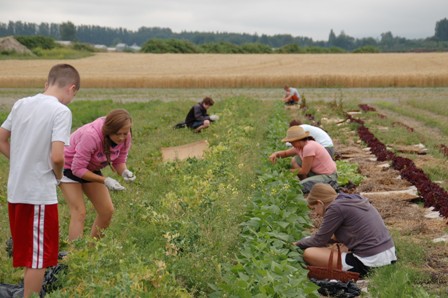
At the end of the day, the whole point of gleaning is getting food to those in need. Thus, it is crucial for the success of any gleaning program to have strong connections to the food banks and meal programs in your area that will ultimately distribute your food. The first step is always compiling a list of local food banks and their contact information. Such lists often already exist and can be found easily online.
Next you need to contact these food banks and tell them about your program. If you are working within a county that has several food banks it is very likely these food banks have a food bank association and meet together in one place. This is an ideal time to talk about your program. Make sure to bring handouts specifically targeted to food banks. If no such meeting exists contact the food banks individually and set up a meeting. Either way, you will eventually want to make sure you speak with each food bank on an individual basis. Also, keep in mind not all food banks may be interested in receiving gleaning donations. Some food banks have limited capacity for dealing with food that needs preparation or cold storage.
Gathering Important Information
To effectively work with food banks and meal programs you will need a lot of information about how they run. This includes things such as:
-
Freezer storage capacity
-
Cooler storage capacity
-
Hours of operation
-
Important Contacts
-
Relative size of distribution
-
Their capacity to process (wash, bag, etc)
All this and more can be gathered in a survey. In addition to this survey, you want to write up a weekly schedule of their hours of operation. Even though they may only be open one day a week to distribute food, a person might be present at the food bank on non-service hours, and willing to receive donations. It is also useful to know what sort of tracking each food bank requires. Some will weigh the produce and record donations themselves, while others will prefer that you give them receipts. All of this information can be gathered during a meeting with the food bank managers or over the phone. To keep this information organized, create a spreadsheet with the survey information of all food banks on one page.
Building a relationship.png )
Food banks rely heavily on volunteer support to run, and are often built on a tight knit group of committed individuals and staff. To work well with these food banks it is important to try and incorporate your program into such community. A strong relationship with food banks can lead to benefits down the road that you might not have expected, such as donations of boxes, volunteer help, or connections to local growers. One of the easiest and most powerful ways to build this relationship is to give the food banks something they are always in need of – volunteer hours!
Volunteering at local food banks, even if it is just once, can have lasting benefits. Logistically it allows you to get a strong grasp on the location and layout of the food bank, which will come in handy later when dropping off food, or giving directions to others who are dropping off food for you. It can also give you hints about the demographics of the food banks, particularly size of distribution. This is very important when trying to decide how much food to send to which food banks. Second, it gives you a chance to get to know the volunteers and staff and a feel for their “business” culture. For example some food banks are a little more laid back, and communication and behavior is more informal. Other food banks might have more of a hierarchy, and stricter procedures. This kind of information may affect how you work with the food bank. Finally, volunteering reflects well on your dedication to your program in the food community.
Volunteering at the food bank is a particularly useful activity in the non-harvest season as it can give you activities to do when work slows down. This is also a great time to volunteer because food banks are usually overwhelmed during the Thanksgiving and Christmas distributions and are in greater need of volunteers.


.png )
